Introduction:
In the ever-evolving landscape of technology, one field that stands out for its transformative impact is computer vision. This groundbreaking discipline empowers machines to interpret and understand visual information, mimicking human vision processes. From facial recognition to autonomous vehicles, computer vision plays a pivotal role in numerous applications, revolutionizing industries and enhancing user experiences.
Understanding the Basics of Computer Vision:
Computer vision involves the development of algorithms and systems that enable machines to process, interpret, and make decisions based on visual data. The process begins with acquiring images or video streams, followed by preprocessing to enhance and simplify the data. Feature extraction and pattern recognition are then employed to identify key elements within the visual information. Finally, the system interprets and acts upon the processed data, enabling machines to "see" and respond to their surroundings.
Applications of Computer Vision:
Medical Imaging:
- Computer vision has revolutionized medical diagnostics through image analysis. From detecting tumors in X-rays to identifying abnormalities in MRI scans, computer vision technologies enhance the accuracy and speed of medical diagnoses.
Autonomous Vehicles:
- The development of self-driving cars relies heavily on computer vision. Cameras, LiDAR, and other sensors collect real-time data, allowing vehicles to navigate, identify obstacles, and make informed decisions on the road.
Facial Recognition:
- Security systems and authentication processes leverage facial recognition powered by computer vision. This technology is widely used in airports, smartphones, and other access control systems.
Augmented Reality (AR) and Virtual Reality (VR):
- Computer vision enriches AR and VR experiences by enabling devices to understand and interact with the user's environment. This is seen in gaming, education, and various industries to create immersive virtual worlds.
Object Recognition:
- From retail to manufacturing, computer vision is employed to recognize and classify objects. This enhances inventory management, quality control, and automation in production processes.
Challenges in Computer Vision:
While computer vision has made remarkable strides, it faces challenges that researchers and developers continually work to overcome:
Data Quality and Quantity:
- The performance of computer vision models is heavily dependent on the quality and quantity of training data. Ensuring diverse and representative datasets is crucial for robust model development.
Complexity of Interpretation:
- Teaching machines to interpret visual information in the same nuanced way humans do is a complex task. Ambiguities, context, and cultural variations add layers of intricacy to the interpretation process.
Real-Time Processing:
- Certain applications, such as augmented reality and autonomous vehicles, require real-time processing of visual data. Achieving low-latency solutions is a continuous challenge for developers.
Ethical and Privacy Concerns:
- The widespread use of facial recognition technology has sparked concerns about privacy and ethical considerations. Striking a balance between innovation and protecting individual rights remains a critical aspect of computer vision development.
Future Trends and Innovations:
Deep Learning Advancements:
- Continued advancements in deep learning algorithms, particularly convolutional neural networks (CNNs), contribute to enhanced accuracy in image recognition tasks.
Edge Computing:
- Moving computation closer to the source of data (edge computing) is gaining prominence in computer vision. This approach reduces latency and enables real-time processing, making it ideal for applications like IoT devices and autonomous systems.
Explainable AI:
- As computer vision models become more complex, there is a growing emphasis on creating models that provide explanations for their decisions. This is crucial for gaining trust and understanding how the system reaches specific conclusions.
Conclusion:
Computer vision has transcended the realm of science fiction, becoming an integral part of our daily lives. From healthcare to transportation, its applications are diverse and impactful. As technology continues to advance, the future of computer vision holds promises of even greater innovation, addressing challenges and unlocking new possibilities for a visually intelligent world.

